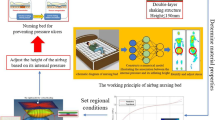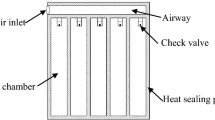Abstract
In order to improve the accuracy of the airbag-based flexible robot in simulating the human body, and make its surface fit the human body surface better. For the balloon filled airbag in flexible robot, the process of airbag parameters under different gas flow is simulated and analyzed. First, for the traditional airbag inflatable simulation method ignoring the different gas volume flow on the impact of airbag deformation. The air bag inflation control model based on gas volume flow is constructed, the pressure of the airbag inflated is optimized by calculation of gas mass flow simulation inflation and leakage. Finally, the grid unit is used to divide the internal volume of the airbag, and its discrete optimization is carried out to simulate the expansion of the airbag. The simulation results show that the simulation method proposed in this paper can complete the process of spherical airbag. The maximum safety pressure of the airbag and the corresponding temperature are obtained from the simulation results, which can provide the theoretical basis for the surface fitting of the flexible garment fitting robot based on airbag.









Similar content being viewed by others
References
Ck, G., Hu, S.Z.: Study on the clothing virtual digital display and online customized business system. Shanghai Text. Sci. Technol. 42(4), 57–60 (2014)
Zeng, Y., Chen, Y.Y., Zhang, Y.: Online virtual fitting system based on humanbody recognition. TV Eng. 38(11), 206–210 (2014)
Chen, X., Hao, K.R., Ding, Y.S.: Simulation of visual servo control for multi-aerocyst flexible fitting robot. Comput. Simul. 31(10), 381–385 (2014)
Sun, W.Y.: Application and prospect of 3D clothing fitting technique in fashion design industry. Shanghai Text. Sci. Technol. 44(10), 38–39 (2016)
Shi, Y.L., Zhang, M.L., Zhang, X.J., Bai, F.: Design and analysis of a rotary-type robot flexible joint. China Mech. Eng. 27(18), 2494–2500 (2016)
Zhang, Q., Xiao, X.H., Wang, Y., You, Penghui, Xie, Tao: Compliant joint for biped robot considering energy consumption optimization. J. Cent. South Univ. Sci. Technol. 46(11), 4070–4076 (2015)
Wang, X.Z., Li, H.Y., Wang, Y.C., Cui, L.: High-precision adaptive backstepping control of flexible joint robots. Inf. Control 45(1), 1–7 (2016)
Zhang, X.R., Liu, Q., Huang, J.Y., Zhu, Y.S.: Simulation of airbag deployment and pressure analysis based on CFD. Sci. Technol. Eng. 15, 209–213 (2015)
Deng, W.B., Peng, B.Y., Ma, L.: A study on airbag inflation and passenger safety based on finite element method. Automob. Technol. z1(1), 29–31 (2006).
Xu, J.J., Ma, L., Wang, X.H.: Numerical simulation of the dynamic permeability of airbag fabrics. J. Donghua Univ. 36(3), 229–232 (2010)
Wang, N., Peng, X.Q., Lu, H.S., Jiang, Y.G.: Folded airbag simulation based on corpuscular particle method. Chin. J. Mech. Eng. 51(12), 120–126 (2015)
Cheng, G., Wang, W.D., Shi, B.J., Wang, Z.L.: FEM and experiment study on compression properties of airbag. China Elastomerics 20(1), 8–12 (2010)
Yang, Y.L., Huang, Y.Q., Xu, Y.L., Lu, P., He, J.G.: Analysis of instrument panel airbag deployment based on particle method. Automob. Technol. 9, 58–61 (2014)
Chen, W.J., Tang, Y.F., Ren, X.Q., Dong, S.L.: Analysis methods of structural design and characteristics of numerical algorithm for ETFE air inflated film structures. Spat. Struct. 4, 38–43 (2010)
Yu, L., Cheng, H., Liu, X.: Numerical simulation of airbag during deploying process. J. Nanjing Univ. Aeronaut. Astronaut. 42(4), 472–476 (2010)
Sun, J.H., Zhou, T., Li, M.Q., Wang, C.L., Yue, C.: Numerical analysis of emergent airbag deployment and ditching crashworthiness process. J. Nanjing Univ. Aeronaut. Astronaut. 44(5), 713–717 (2012)
Zhou, S.M., Li, D.K., Tang, G.J.: Nonlinear finite element analysis of inflatable self-sealing bladder. Lubr. Eng. 10, 59–63 (2010)
Dai, X.F., Zong, Z., Wang, X.J., Nie, C.: A comparative study on the CV and ALE methods for simulating folded airbag deployment. Automot. Eng. 30(8), 676–680 (2008)
Yang, Y.Z., Jin, X.L., Zhang, G., Wei, W.: Numerical simulation of ALE multi-material method for a composite membrane air-charge mattress. J. Vibr. Shock 31(8), 107–111 (2012)
Lu, S.B., Dong, L.P., Chen, G., Zhang, J.Y., Yang, Z.C.: Numerical simulation of curtain airbag deployment based on arbitrary Lagrangian–Eulerian algorithm. Automot. Eng. 31(12), 1158–1161 (2009)
Acknowledgements
This work was supported by the National Natural Science Foundation of China (Grant No. 51675490), and Young Academic Team Project of Zhejiang Shuren University.
Author information
Authors and Affiliations
Corresponding author
Ethics declarations
Conflict of interest
The authors declare that there is no conflict of interests regarding the publication of this paper.
Rights and permissions
About this article
Cite this article
Hu, F. Simulation and analysis of airbag parameter variation under different gas flows. Cluster Comput 22 (Suppl 6), 13235–13245 (2019). https://doi.org/10.1007/s10586-018-1834-7
Received:
Revised:
Accepted:
Published:
Issue Date:
DOI: https://doi.org/10.1007/s10586-018-1834-7




